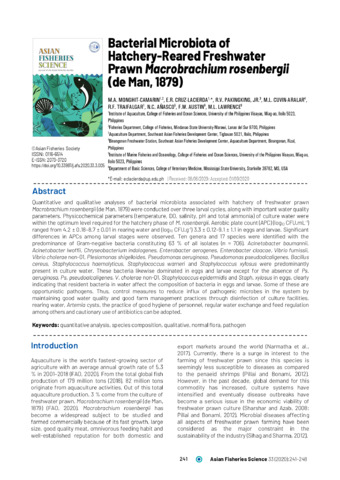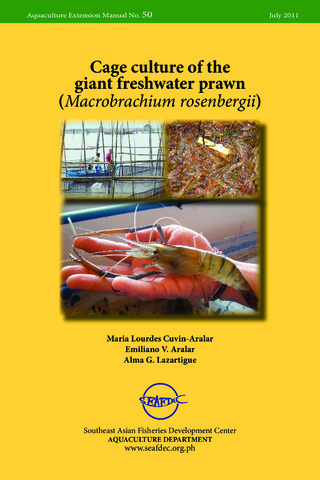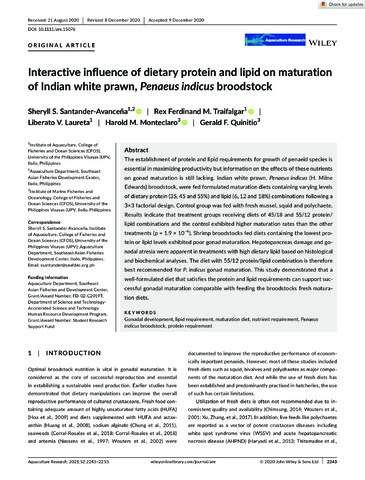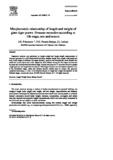Bacterial microbiota of hatchery-reared freshwater prawn Macrobrachium rosenbergii (de Man, 1879)

Quan điểm/
Ngày
2020-09-30Tác giả
Page views
44,389metadata
Hiển thị bản ghi đầy đủ mặt hàngCited times in Scopus
Share
trừu tượng
Quantitative and qualitative analyses of bacterial microbiota associated with hatchery of freshwater prawn Macrobrachium rosenbergii (de Man, 1879) were conducted over three larval cycles, along with important water quality parameters. Physicochemical parameters (temperature, DO, salinity, pH and total ammonia) of culture water were within the optimum level required for the hatchery phase of M. rosenbergii. Aerobic plate count (APC) (log10 CFU.mL-1) ranged from 4.2 ± 0.18–8.7 ± 0.01 in rearing water and (log10 CFU.g-1) 3.3 ± 0.12–9.1 ± 1.1 in eggs and larvae. Significant differences in APCs among larval stages were observed. Ten genera and 17 species were identified with the predominance of Gram-negative bacteria constituting 63 % of all isolates (n = 706). Acinetobacter baumannii, Acinetobacter lwoffii, Chryseobacterium indologenes, Enterobacter aerogenes, Enterobacter cloacae, Vibrio furnissii, Vibrio cholerae non-01, Plesiomonas shigelloides, Pseudomonas aeruginosa, Pseudomonas pseudoalcaligenes, Bacillus cereus, Staphylococcus haemolyticus, Staphylococcus warneri and Staphylococcus xylosus were predominantly present in culture water. These bacteria likewise dominated in eggs and larvae except for the absence of Ps. aeruginosa, Ps. pseudoalcaligenes, V. cholerae non-01, Staphylococcus epidermidis and Staph. xylosus in eggs, clearly indicating that resident bacteria in water affect the composition of bacteria in eggs and larvae. Some of these are opportunistic pathogens. Thus, control measures to reduce influx of pathogenic microbes in the system by maintaining good water quality and good farm management practices through disinfection of culture facilities, rearing water, Artemia cysts, the practice of good hygiene of personnel, regular water exchange and feed regulation among others and cautionary use of antibiotics can be adopted.
Suggested Citation
Monghit-Camarin, M.-A., Cruz-Lacierda, E. R., Pakingking, R. V., Jr., Cuvin-Aralar, M. L., Traifalgar, R. F., Añasco, N. C., Austin, F. W., & Lawrence, M. L. (2020). Bacterial microbiota of hatchery-reared freshwater prawn Macrobrachium rosenbergii (de Man, 1879). Asian Fisheries Science , 33(3), 241-248. https://doi.org/10.33997/j.afs.2020.33.3.005
Chủ thể
Bộ sưu tập
- AQD Journal Articles [1249]
Related items
Showing items related by title, author, creator and subject.
-
Cage culture of the giant freshwater prawn (Macrobrachium rosenbergii)
Cuvin-Aralar, Maria Lourdes; Aralar, Emiliano V.; Lazartigue, Alma G. (Aquaculture Department, Southeast Asian Fisheries Development Center, 2011)An extension manual describing biology, site requirement, grow-out operations, health management, harvest, post harvest handling and processing, and economic analysis. -
Interactive influence of dietary protein and lipid on maturation of Indian white prawn, Penaeus indicus broodstock
Santander-Avancena, Sheryll; Traifalgar, Rex Ferdinand; Laureta, Liberato V.; Monteclaro, Harold; Quinitio, Gerald (Wiley, 2021)The establishment of protein and lipid requirements for growth of penaeid species is essential in maximizing productivity but information on the effects of these nutrients on gonad maturation is still lacking. Indian white ... -
Morphometric relationship of length and weight of giant tiger prawn Penaeus monodon according to life stage, sex and source
Primavera, J. H.; Parado-Estepa, F. D.; Lebata, J. L. (Elsevier, 1998)Regression analysis was performed on length–weight and length–length measurements of Penaeus monodon (n=3270 individuals) including carapace length, body length, total length and body (wet) weight of different life stages ...



